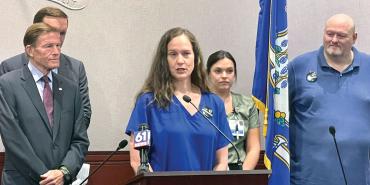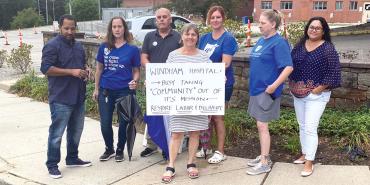From working conditions becoming unbearable to basic services becoming inaccessible, far too many healthcare professionals and their patients are overwhelmed, stressed, and scared. The union movement is here to help; we’re fighting for safe staffing and affordable care so that patients get the services they need, we’re getting out the vote for candidates who understand that our healthcare system is in crisis, and we’re pressuring employers to put patients and staff over profits.
For insights into healthcare’s challenges and how the upcoming elections could spur improvements, we spoke with Sherri Dayton, RN, BSN, CEN. Dayton, a full-time emergency room nurse with 30 years of healthcare experience, is also the president of the Backus Federation of Nurses in Norwich, Connecticut, and the divisional vice president of AFT Connecticut for healthcare.
–EDITORS
EDITORS: What are some of the main challenges your members faced before and during the pandemic?
Before the pandemic, nurses were having a hard time with staffing shortages and mandatory overtime. Without reasonable nurse-patient ratios, my members were overworked. Working conditions were not ideal for work-life balance, staff retention, or patient safety.
During the pandemic, it’s been so much worse. I’m an emergency room nurse. On a recent shift, I had seven patients—seven to one—that’s unheard of! These are unstable patients; we don’t know what’s wrong with them yet. They could be critical, and we just don’t know it. Seven patients is hard no matter what department you’re working in, but in the ER, it’s especially dangerous.
On top of the staffing crisis, we have seen an uptick in people bringing knives and guns into the ER. Since the pandemic, violence is worsening. People seem angrier—they seem to have less patience and compassion. Unfortunately, that intensifies when people don’t feel good or are worried about their loved ones. We’re constantly asking, “What can we do to make this safer for other patients and ourselves?”
EDITORS: Tell us more about the staffing problems. Why are so many people leaving?
We knew before the pandemic that we were heading into another shortage of healthcare professionals, in part because baby boomers are retiring and becoming patients. Then the pandemic hit. Most people who could retire did so, even though it was sooner than they planned, because they feared getting COVID-19. Many others changed from regular schedules to per diem, exacerbating the shortage.
But what we’re seeing now is different. I’ve been in the healthcare field for 30 years and I’ve not seen this before, which is really scary for me. People are coming out of nursing school and within one to five years, they’re leaving the profession—not leaving their job to do something else in nursing but leaving the healthcare profession. To walk away from a profession you worked so hard to attain is mind-blowing to me. Most people get into healthcare because they feel the calling to help people. But the working conditions are driving them away.
Here in Connecticut, more than 25 percent of the people who hold a nursing license are not working in the field right now.1 So there isn’t a nursing shortage; there’s a shortage of people who want to work under these conditions. We work shifts without time to eat, sip water, or go to the restroom. Paid time off is routinely denied—there’s no work-life balance at all. Worse, when you’re working without enough staff, you’re always terrified of making a mistake, hurting a patient, and losing your license. And even if you don’t make a mistake, you still need more time. Study after study has shown that how often the nurse is in the room directly correlates with the patient’s outcomes—from falls to pressure ulcers, to infections, to morbidity.2 My members and I often feel like we’re set up for failure because there are so many holes in the healthcare system.
Another very concerning problem is the shortage of nursing faculty. We have far more qualified applicants for nursing school than seats. In 2021, only 23 percent of the qualified applicants in Connecticut could be accepted.3 Some will wait until the next year and reapply. But many will go into different careers; for example, some become dental hygienists because there are seats available in that program—and then we’ve lost the nurse. I’ve long thought teaching would be a good plan for the later part of my career because bedside nursing and acute care nursing are rough on your body—but recently I learned that after spending $40,000 on my master’s degree, I’ll be making the same amount of money I make now. Instead of enrolling in a master’s program for nursing education, I enrolled in a nurse practitioner program. So, that’s one important cause of the nursing faculty shortage. For prospective nurses and faculty, tuition reimbursement and loan forgiveness are desperately needed.
EDITORS: Federal and state legislators could make preparation for healthcare professions more affordable, so let’s talk about the upcoming elections. What changes do you hope to see?
What I’m most excited about is that we have three strong unionists running for our state senate: Martha Marx, Jan Hochadel, and Julie Kushner. Marx has been a registered nurse for almost four decades and is president of AFT Local 5119. Hochadel, a former high school science teacher, is president of AFT Connecticut. And Kushner, who became a state senator in 2018, is a former regional director with the United Auto Workers. All three understand the needs of working families and the importance of improving working conditions in healthcare. And with all three in the state senate, we have a great chance to pass a bill strengthening limits on mandatory overtime in hospitals. That would have a huge impact because our work is very stressful and having a regular schedule—being able to plan on spending time with family and friends—would reduce our compassion fatigue and moral injury.
Other high priorities are legislation to prevent hospitals from shutting down or reducing services in higher-need, less-profitable communities and to set safe patient limits so that we’re no longer assigned more patients than we can responsibly handle. Those are longer-term goals, but with more labor and healthcare candidates running, we’ll soon have more elected officials who understand our concerns.
Safe patient limits are really crucial. With them, we can take our breaks. We can be at the bedside when our dying patient needs to hold our hand. Almost all of the issues that keep us up at night would be resolved. I say almost because we also have to deal with workplace violence. I have had things thrown at me—big things, like computers. I’ve had people swing at me, kick me, bite me, spit at me, and call me every name in the book. But I’ve been fortunate. One of my friends has had multiple shoulder surgeries after being flipped over by a patient. Another has been unable to return to work because of posttraumatic stress from being assaulted by a patient.
We’ve fought for simple changes, such as not having our last names on our badges so patients can’t find us online easily and increasing the lighting and security around the hospital so nurses and other workers feel safe as they come and go. We’re also advocating for US Rep. Joe Courtney’s (D-CT) Workplace Violence Prevention for Healthcare and Social Service Workers Act, which would require the Occupational Safety and Health Administration to establish an enforceable standard so that employers create safer environments.4 Hospitals have proven that they are not going to address violence on their own. They’ve had decades to do the right thing, the safe thing, the caring thing—but my members are still being injured. So, when I go to the ballot box, I’m looking for candidates who understand and want to protect healthcare professionals.
EDITORS: Beyond the staffing and violence crises you’ve already described, what else do you want candidates to understand?
When I was in preschool and my teacher asked, “What do you want to be when you grow up?,” I said, “A nurse.” Here I am 30 years into it, and I don’t regret it. I love my profession. But I got into it because I wanted to take care of people. On the days that I have wanted to quit being a nurse, it’s because I wasn’t able to give good care.
I work in the ER for a very particular reason: I don’t have to ask patients about their insurance. When I was a visiting nurse, I hated seeing that a patient’s insurance and ability to pay determined the type of care that we could provide. I think that’s inhumane. Turning a sick child away because of their family’s inability to pay is heartbreaking, so I’m strongly in favor of Medicare for all.
Even working in the ER, I see the impact of our unjust system. I had a patient recently who was on a blood thinner; he fell and hit his head but waited a couple of days to come in. I asked, “Why did you wait so long? If you fall and you hit your head, you need to come in the ER immediately because you could be bleeding internally; you could go to sleep and not wake up.” He said, “I can’t afford it. I can’t afford to come.” He could have died in his sleep, and he knew it. It crushes me.
Healthcare is a human right. Other countries offer universal healthcare; we should be able to set aside our political differences and take care of everyone in our country too.
I also want candidates to understand how unions build the middle class. In my experience, unions are good for all workers—not just the unionized workers. At the hospital where I work, we have 400 nurses who are unionized. After we went on strike in 2020 and won significant raises in our contract, the administrators gave everybody else in the hospital a 2 percent raise. That was not planned; they had already done the evaluations that year and told the nonunion staff what their raises were going to be. I’m sure that 2 percent came from people talking about what a large raise we got by striking. That’s the way it works: union activism lifts all workers. It’s not all about pay; it’s also about paid time off and other benefits. Unions pressure organizations to be better employers. I think it’s vitally important that we get more labor-friendly people into office so we can pass legislation like the Protecting the Right to Organize Act that would make unionization easier.5
One last issue I want candidates to grasp is that there’s a growing crisis of corporations buying small community hospitals. The corporations say they are regionalizing care, but for many patients, that means care is farther away or totally inaccessible. For example, diabetic education and wound care may be taken from a small local facility and placed in the larger regional facility. Then a patient has to drive 30 to 45 minutes, but when you have a big wound on your leg, it’s painful to be sitting in a car for a long period. And if you don’t have a car, you don’t get the care at all because you can’t get to the regional facility. Elected officials should be scrutinizing this consolidation and protecting their constituents. Instead of only considering corporations’ profits, we must consider communities’ needs.
Another aspect of consolidation, which most people seem unaware of, is that many of these large healthcare corporations are nonprofits, so they don’t pay taxes. These regionalized hospitals and clinics are very lucrative, but their nonprofit status means they are not contributing to their communities. They may be the largest building owner in the region, but they don’t contribute to building or repairing roads, for example. If they are going to retain their nonprofit perks, they should at least give back by providing the necessary care in each community. My union—and many others—are advocating for state legislation that would not allow needed health services to be taken away or moved to a regional hub. So that’s another key issue I consider when deciding who is getting my vote.
EDITORS: We often focus on our democracy in the months before an election, but true democratic engagement requires day-to-day activism. What will your union be doing after the election?
Getting family-, worker-, and healthcare-friendly candidates elected is just the first step. Once they’re in office, they are bombarded with lobbyists. So we have to stay in touch with our elected officials and ensure that they fulfill their promises. By calling, emailing, and showing up at the capital, we remind our representatives about our issues. We also have to stay engaged as bills are drafted and debated so we can explain the real-world implications of any proposed changes. Most of all, we have to be persistent. We might only move one baby step forward this session, and then we get ready to fight for a bigger step in the next session.
I know it can be exhausting, but it’s important. This is especially true at the state and local levels, where the laws, policies, and budgets so directly affect our everyday lives.
Healthcare professionals really need a silver lining coming out of the pandemic. The healthcare system was broken before COVID. It is in crisis now. The one good thing I hope to see is elected officials finally starting to make changes.
Endnotes
1. Connecticut League for Nursing, “Nearly Half of CT-Licensed Nurses Don’t Work in Connecticut. Need for Nurses Exceeds Workforce Supply Based on Retirements and Working Conditions,” press release, February 2, 2022.
2. J. Phillips, A. Malliaris, and D. Bakerjian, “Nursing and Patient Safety,” PSNet, Agency for Healthcare and Research Quality, US Department of Health and Human Services, April 21, 2021; Department for Professional Employees, “Safe Staffing: Critical for Patients and Nurses: 2019 Fact Sheet,” AFL-CIO, April 15, 2019; and B. Cohen et al., “Frequency of Patient Contact with Health Care Personnel and Visitors: Implications for Infection Prevention,” Joint Commission Journal on Quality and Patient Safety 38, no. 12 (December 2012): 560–65.
3. E. Phillips, “Demand for Nurses Is Urgent. CT’s Colleges and Universities Can’t Keep Up,” CT Mirror, June 12, 2022.
4. Office of Congressman Joe Courtney, “Workplace Violence Prevention for Healthcare and Social Service Workers Act.”
5. AFL-CIO, “What Is the PRO Act?”
[Photos, from top: courtesy of Matt O’Connor / AFT Connecticut; courtesy of Sherri Dayton]



